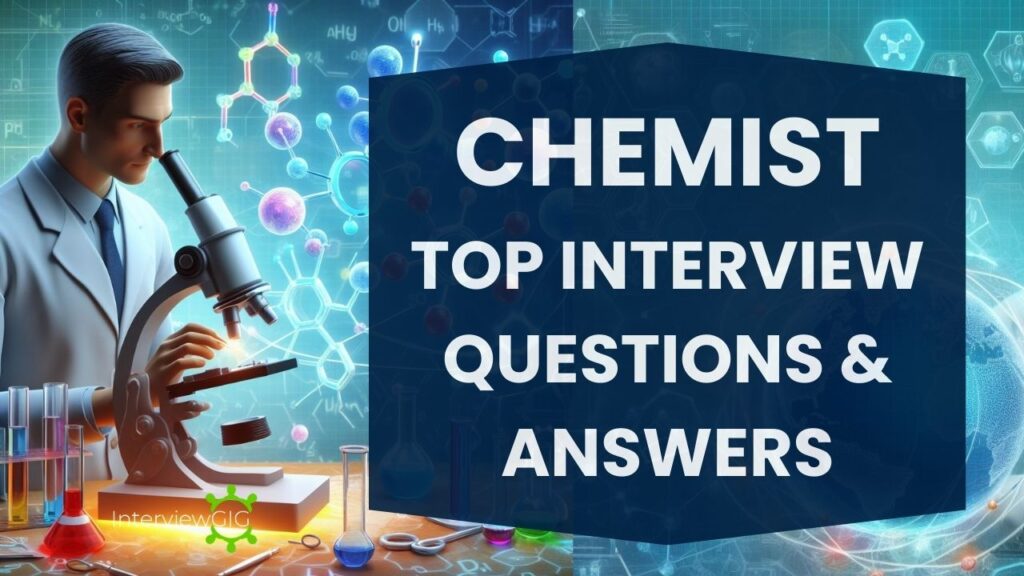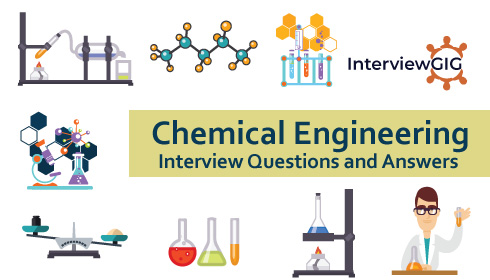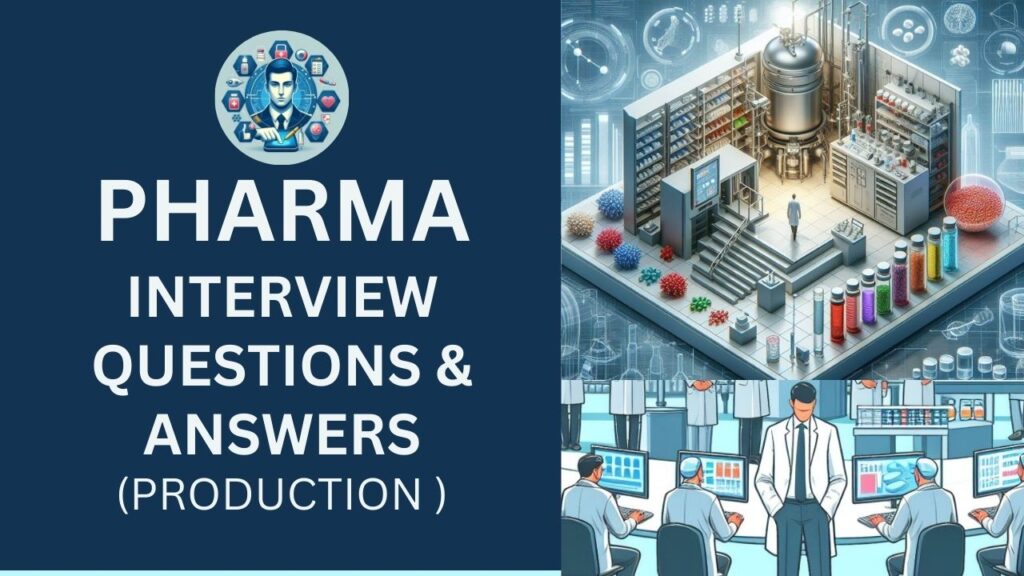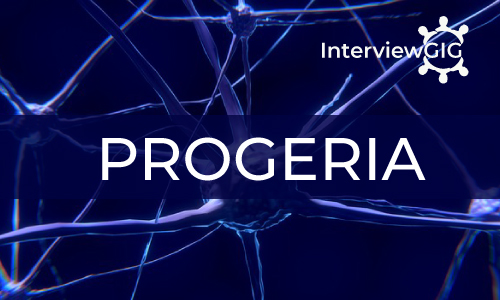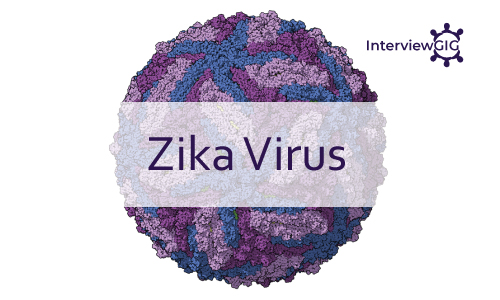In this article, we offer a comprehensive set of top interview questions and answers tailored for Chemists across various fields, including production, API production, manufacturing, QA, QC, R&D, and more. These questions cater to both beginners and experienced candidates, equipping them with the necessary insights to prepare effectively for their upcoming interviews. Whether you’re entering the field or seeking to advance your career, these interview resources will help you navigate discussions on diverse topics within the realm of chemistry-related roles.
Production Chemist:
Question: Can you describe your understanding of the production process in a chemical manufacturing setting?
Answer: The production process in a chemical manufacturing setting can be broadly divided into several stages:
- Raw material handling and storage: Ensuring proper identification, storage, and handling of materials to prevent contamination and maintain safety.
- Reaction and processing: Carrying out chemical reactions in reactors under controlled conditions like temperature, pressure, and mixing.
- Separation and purification: Extracting the desired product from the reaction mixture using techniques like filtration, distillation, or chromatography.
- Finishing and packaging: Finalizing the product by adjusting its form, concentration, or packaging it for distribution.
Each stage involves specific equipment, procedures, and quality control measures.
Question: What safety measures would you implement during the production of chemical products?
Answer: Safety is paramount in chemical manufacturing. I would implement measures such as regular safety training for personnel, strict adherence to Personal Protective Equipment (PPE) protocols, and thorough risk assessments before starting any new production process. Additionally, implementing engineering controls, emergency response plans, and regular safety audits contribute to maintaining a safe production environment.
Question: How do you troubleshoot and solve problems in a production setting? Can you share an example?
Answer: Production issues can arise. Effective troubleshooting involves:
Identifying the problem: Recognizing deviations from standard operating procedures or product specifications.
Data analysis: Reviewing process data, lab results, and equipment logs to pinpoint the root cause.
Brainstorming potential solutions: Considering various options and their impact on safety, efficiency, and quality.
Testing and implementation: Trying the most promising solution on a small scale and monitoring its effectiveness.
Documentation and communication: Recording the issue, solution, and outcome for future reference and knowledge sharing.
An example is when we encountered an unexpected yield drop. After careful investigation, we found a temperature variation in the reactor. Adjusting the parameters resolved the issue, and we implemented additional monitoring to prevent reoccurrence.
Question: What experience do you have with process optimization and yield improvement?
Answer: I have experience in optimizing chemical processes to improve efficiency and yield. In a previous role, I implemented changes in reaction conditions and catalysts, resulting in a 15% increase in overall yield. Regular process monitoring, statistical analysis, and collaboration with the research and development team played a key role in achieving these improvements
Question: How do you ensure efficiency and quality in the production of chemical compounds?
Answer: Ensuring efficiency and quality involves:
Standardized procedures: Following documented protocols for every step to maintain consistency.
Quality control: Testing raw materials, intermediates, and finished products at designated checkpoints.
Continuous improvement: Regularly reviewing processes and implementing updates based on data and feedback.
Calibrating instruments: Maintaining the accuracy and reliability of analytical equipment.
Question: Discuss your understanding of different reactor types and their suitability for specific chemical reactions.
Answer: Different reactor types suit specific reactions based on:
Batch vs. continuous: Batch reactors handle smaller quantities but offer flexibility, while continuous reactors process larger volumes more efficiently.
Stirred tank vs. plug flow: Stirred tanks ensure good mixing, while plug flow reactors maintain reaction conditions throughout.
Specialized reactors: Some reactions require specific designs like membrane reactors or fluidized bed reactors.
Question: What are the different analytical methods used for quality control in chemical production?
Answer:
Common methods include:
Various analytical methods are employed for quality control in chemical production, including High-Performance Liquid Chromatography (HPLC), Gas Chromatography (GC), Mass Spectrometry, and Nuclear Magnetic Resonance (NMR).
Titration: Quantitatively measuring the concentration of a specific component.
pH and conductivity meters: Monitoring reaction progress and product purity.
These methods help in verifying the purity, composition, and consistency of the final chemical product.”
Question: Can you give an example of a challenge you faced in a production environment and how you addressed it?
Answer: One challenge I faced was a sudden change in the viscosity of a polymer during production. Through collaboration with the production team and analysis of process parameters, we identified an issue with the mixing speed. Adjusting the mixing speed and implementing real-time viscosity monitoring resolved the challenge, ensuring the production continued smoothly with the desired product quality.
API Production:
Question: What does API stand for, and what is its significance in pharmaceuticals?
Answer: API stands for Active Pharmaceutical Ingredient. It is the biologically active component in a pharmaceutical drug responsible for its therapeutic effect.
Significance of API:
Core of Pharmaceutical Action: The API triggers the desired physiological response to treat a disease or alleviate symptoms.
Drug Development & Formulation: Different APIs can be combined or formulated (added with inactive ingredients) to create various medications.
Cost & Accessibility: API cost significantly impacts drug affordability and accessibility, especially for essential medicines.
Question: Explain the process of API production from a chemical synthesis perspective.
Answer: Here’s a simplified view of API production through chemical synthesis:
Starting Materials: Choose and source raw materials (building blocks) with high purity and quality.
Reaction & Processing: Conduct controlled chemical reactions (construction) using various techniques like:
- Batch or Continuous Reactors: Mixing and transforming raw materials under specific conditions (temperature, pressure, catalysts).
- Separation & Purification: Isolating the desired API (removing unwanted products) through techniques like filtration, chromatography, or crystallization.
Finalization: Finishing touches for API: drying, adjusting form (powder, granules), and packaging under strict quality control.
Question: What are the key considerations in designing a synthetic route for API production?
Answer: Designing a synthetic route for API production involves several considerations, including:
- Chemical Selectivity: Ensuring the desired reaction pathways occur selectively to produce the target API.
- Yield: Maximizing the conversion of starting materials to the final product to achieve high yields.
- Safety: Identifying and mitigating potential safety hazards associated with the chemical reactions.
- Environmental Impact: Considering the environmental impact of reagents and by-products.
- Cost: Balancing the cost-effectiveness of the synthetic route, considering the availability and cost of raw materials.
Question: Describe the role of quality control in API production.
Answer: Quality control in API production is critical to ensure the safety, efficacy, and consistency of the final pharmaceutical product. It involves:
- Raw Material Testing: Checking the quality of starting materials.
- In-Process Testing: Monitoring and controlling the synthesis process at various stages.
- Final Product Testing: Assessing the purity, identity, and potency of the API.
- Stability Testing: Evaluating the API’s stability under various conditions.
- Compliance: Ensuring adherence to Good Manufacturing Practices (GMP) and other regulatory requirements.
Question: What are the challenges faced in scaling up API production from lab-scale to industrial-scale?
Answer: Scaling up API production presents challenges such as:
- Reaction Optimization: Conditions that work well on a small scale may need adjustment for larger volumes.
- Heat and Mass Transfer: Ensuring efficient heat and mass transfer in larger reactors.
- Process Safety: Identifying and addressing safety concerns associated with larger quantities of reactants.
- Purification: Developing scalable purification methods to maintain product quality.
- Economic Considerations: Balancing the cost-effectiveness of the process at an industrial scale.
Question: How do you ensure regulatory compliance in API production?
Answer: Ensuring regulatory compliance is paramount in API production to guarantee safety, efficacy, and quality. Here are key strategies:
Understanding Regulations: Thoroughly understanding relevant regulations like cGMP (Current Good Manufacturing Practices) and ICH guidelines for each market.
Quality Management System (QMS): Implementing a robust QMS with documented procedures, SOPs (Standard Operating Procedures), and training programs.
Routine Audits and Inspections: Conducting regular internal and external audits to identify and address potential compliance gaps.
Data Integrity: Maintaining accurate and complete records of all production activities and quality control measures.
Change Management: Implementing a defined process for handling changes to processes, materials, or equipment while maintaining compliance.
Supplier Management: Selecting and qualifying suppliers who meet quality and regulatory standards.
Question: What is the importance of process optimization in API production?
Answer: Process optimization in API production is crucial for several reasons:
- Efficiency: Optimizing processes enhances overall efficiency, reducing production time and costs.
- Yield Improvement: Optimization helps maximize the yield of the desired API, improving the economic viability of production.
- Quality Control: A well-optimized process contributes to consistent and high-quality API production.
- Safety: Optimization considers and mitigates potential safety hazards associated with the production process.
Question: Explain the concept of green chemistry and its relevance in API manufacturing?
Answer: Green chemistry aims to minimize environmental impact throughout the production process. Its relevance includes:
- Using safer and less hazardous solvents and reagents.
- Developing reactions with minimal waste generation and energy consumption.
- Designing processes for efficient water and resource utilization.
- Implementing sustainable disposal methods for waste products.
- Selecting renewable or recyclable materials whenever possible.
Green chemistry not only benefits the environment but can also improve production efficiency and cost-effectiveness.
Question: Describe the role of analytical techniques such as HPLC, GC, and NMR in API characterization?
Answer:
- HPLC (High-Performance Liquid Chromatography): HPLC is used for separating, identifying, and quantifying components in a complex mixture. In API characterization, it helps determine purity and assess the presence of impurities.
- GC (Gas Chromatography): GC is valuable for separating and analyzing volatile compounds. It is often used to analyze volatile impurities in APIs.
- NMR (Nuclear Magnetic Resonance): NMR provides detailed structural information about molecules, aiding in the determination of the molecular structure and confirming the identity of the API.
Question: How does API research contribute to drug discovery and development?
Answer: API research is integral to drug discovery and development as it involves the identification, synthesis, and characterization of potential active pharmaceutical ingredients. The contributions include:
Targeted Therapies: API research targets specific biological processes or molecular structures, contributing to the development of targeted therapies.
Efficacy and Safety: Understanding the properties of APIs helps in designing molecules with optimal therapeutic efficacy and minimal side effects.
Optimization for Formulation: API research informs the development of formulations that optimize the delivery of the drug to the target site in the body.
Intellectual Property: Novel APIs resulting from research efforts can lead to the establishment of intellectual property, providing a competitive advantage in the pharmaceutical market.
Manufacturing:
Question: What is your understanding of Good Manufacturing Practices (GMP) and how do you apply them in your work?
Answer: Good Manufacturing Practices (GMP) are a set of quality assurance principles and procedures aimed at ensuring the safety, quality, and consistency of pharmaceutical, food, and cosmetic products. In my work, I adhere to GMP by following established protocols, maintaining a clean and organized workspace, regularly calibrating equipment, and documenting all processes meticulously. Continuous training and staying updated on industry regulations help me uphold GMP standards.
Question: Can you discuss any experience you have with optimizing manufacturing processes for efficiency?
Answer: In a previous role, I led a project to optimize a chemical manufacturing process. Through careful analysis of the reaction conditions, we identified a bottleneck and modified the process parameters. This resulted in a 20% reduction in production time and a significant increase in overall efficiency. Regular monitoring and collaboration with the production team were essential to successfully implement and sustain these improvements.
Question: What is the importance of safety protocols in a chemical manufacturing environment?
Answer: Safety protocols in a chemical manufacturing environment are paramount to protect personnel, the facility, and the surrounding environment. These protocols encompass the proper handling of chemicals, the use of personal protective equipment (PPE), emergency response procedures, and regular safety training. Adhering to these protocols minimizes the risk of accidents, exposure to hazardous substances, and ensures a secure working environment for all.
Question: How do you handle hazardous materials, and what precautions do you take to ensure a safe working environment?
Answer: Handling hazardous materials requires strict adherence to safety procedures. I ensure proper labelling, storage, and disposal of chemicals. Personal protective equipment (PPE), such as gloves and goggles, is consistently worn. Ventilation systems are maintained, and spill response kits are readily available. Regular risk assessments and safety audits help identify and mitigate potential hazards, contributing to a safe working environment.
Question: Can you provide an example of a situation where you had to respond to an emergency or safety incident?
Answer: In a previous role, a chemical spill occurred during a manufacturing process. I immediately activated the emergency response protocol, ensuring the affected area was evacuated, and the spill was contained. I communicated with the emergency response team, facilitated the cleanup using appropriate materials, and conducted a thorough investigation to understand the root cause. Lessons learned from this incident led to the enhancement of safety measures, including additional training on spill response procedures.
Quality Assurance (QA):
Question: What is the role of QA in chemical manufacturing, and why is it important?
Answer: Quality Assurance (QA) in chemical manufacturing involves overseeing and ensuring that all processes and products meet predefined quality standards. The role includes establishing quality protocols, conducting inspections, and implementing corrective actions. QA is crucial for maintaining product consistency, meeting regulatory requirements, and ensuring customer satisfaction by delivering high-quality and safe chemical products.
Question: How would you approach implementing and maintaining quality standards in a production facility?
Answer: Implementing and maintaining quality standards requires a systematic approach. I would start by developing comprehensive Standard Operating Procedures (SOPs) that outline quality requirements at each production stage. Regular training sessions for personnel would ensure awareness and adherence to these standards. Continuous monitoring, periodic internal audits, and collaboration with different departments contribute to the ongoing maintenance of quality standards.
Question: Can you provide an example of how you would conduct a quality audit or inspection?
Answer: Conducting a quality audit involves a thorough review of processes, documentation, and facility conditions. I would begin by creating an audit plan detailing specific areas to be examined, such as production records, equipment calibration, and adherence to SOPs. During the audit, I would engage with personnel, inspect equipment, and review documentation. The findings would be documented, and corrective actions, if necessary, would be discussed and implemented.
Question: How do you handle deviations from quality standards, and what corrective actions would you take?
Answer: Handling deviations from quality standards requires a prompt and systematic approach. Upon identification of a deviation, I would initiate an investigation to determine the root cause. Once identified, corrective actions would be implemented, addressing both the immediate issue and preventing its recurrence. This may involve revising SOPs, providing additional training, or making process adjustments. Throughout the process, clear communication with relevant stakeholders is essential.
Question: Explain the process of risk assessment in quality assurance for chemical products.
Answer: Risk assessment in quality assurance involves identifying potential risks that could impact product quality or safety. This includes evaluating raw materials, production processes, and external factors. The process includes:
-
- Identification of Risks: Identifying potential risks associated with each stage of production.
- Risk Analysis: Assessing the likelihood and severity of identified risks.
- Risk Mitigation: Implementing measures to reduce or eliminate identified risks.
- Regular Review: Periodically reassessing and updating the risk assessment to adapt to changes in the production environment or regulations.
Quality Control (QC):
For More Quality Control Interview Questions and Answers watch below Video.
Question: What is the difference between QA and QC in the context of chemical manufacturing?
Answer: Quality Assurance (QA) and Quality Control (QC) are distinct but interconnected aspects of quality management. QA focuses on processes and systems to ensure that the final product meets quality standards. It involves implementing and maintaining quality management systems, setting standards, and conducting audits. QC, on the other hand, involves actual testing and inspection of products to identify and correct deviations from established standards. While QA is more preventive, QC is corrective and involves testing and inspection activities.
Question: How do you perform analytical testing to ensure the quality of raw materials and finished products?
Answer:
Analytical Testing for Quality:
- Raw Material Testing: Assesses purity, identity, and conformance to specifications using techniques like:
HPLC: Separates and quantifies components for impurity detection.
Spectroscopy: Identifies molecular structure and verifies identity.
Titration: Measures specific compounds for quantitative analysis.
- Finished Product Testing: Ensures final product meets specifications and quality standards through:
Chromatography: Detects trace impurities and verifies product composition.
Spectroscopy: Confirms product identity and analyzes potential degradants.
Physical testing: Evaluates properties like melting point, color, and solubility.
Question: What techniques do you use to validate analytical methods for quality control purposes?
Answer: Method validation is crucial to ensuring the reliability and accuracy of analytical results. I follow industry guidelines such as International Conference on Harmonisation (ICH) guidelines for method validation. The process includes assessing parameters like accuracy, precision, specificity, and robustness. Techniques such as spike recovery experiments, standard addition methods, and comparison with reference methods are employed to validate analytical methods for quality control purposes.
Question: Can you discuss your experience with different analytical techniques such as HPLC, GC, and spectroscopy in the context of quality control?
Answer:
HPLC: Extensive use for separating and quantifying various chemical components in complex mixtures.
GC: Valuable for analyzing volatile and gaseous compounds in raw materials and finished products.
Spectroscopy: Diverse techniques like UV-Vis, IR, and NMR widely used for structure elucidation, quantitative analysis, and impurity detection.
Question: Can you discuss your experience with instrumentation used in QC, such as spectrophotometers or chromatographs?
Answer: I have hands-on experience with a range of instruments used in quality control. Spectrophotometers are utilized for measuring the absorbance or emission of light by a substance, aiding in concentration determination. Chromatographs, such as HPLC and GC, are essential for separating and analyzing components in a sample. Familiarity with these instruments, including calibration, maintenance, and troubleshooting, is integral to ensuring accurate and reliable analytical results.
Question: What is the importance of Good Manufacturing Practices (GMP) and Good Laboratory Practices (GLP) in the context of quality control?
Importance of GMP and GLP:
GMP (Good Manufacturing Practices): Ensures quality and safety of manufactured products through standardized processes, documentation, and controls. This guarantees consistency and minimizes risks in production.
GLP (Good Laboratory Practices): Ensures the accuracy and reliability of laboratory data used for product development and testing. This builds trust in the scientific evidence supporting product safety and efficacy.
Question: How do you handle the introduction of new products or processes into the quality control system?
Answer: Quality Control with New Products/Processes:
Thorough evaluation:
- Assess if existing quality control procedures are suitable for the new product/process.
- Identify potential risks and adjust controls accordingly.
- Ensure staff is trained on new methods and procedures.
Validation:
- Confirm new methods/processes produce accurate and reliable results.
- Establish control limits and acceptance criteria.
- Document the validation process thoroughly.
Change control:
- Implement documented procedures for any modifications to the new product/process.
- Re-evaluate quality control procedures if necessary.
Continuous monitoring:
- Regularly monitor product/process performance and data trends.
- Detect and address any deviations from control limits promptly.
Simple Analogy: Imagine building a house. GMP is the blueprint ensuring consistent, safe construction. GLP is like testing the foundation and materials for quality and reliability. When adding a new room, you adjust the plan (procedures), test the new materials (validation), and ensure everything remains structurally sound (monitoring).
Question: What steps would you take if you identified a product that did not meet quality specifications?
Answer: If a product does not meet quality specifications, I would:
- Quarantine the affected batch to prevent distribution.
- Initiate an investigation to identify the root cause.
- Implement corrective actions to address the issue promptly.
- Assess the impact on other batches or products.
- Update documentation and communicate findings to relevant stakeholders.
- Review and revise processes or controls to prevent recurrence.
Research and Development (R&D):
Question: How do you approach designing an experiment to test a hypothesis?
Answer: When designing an experiment, I start by clearly defining the hypothesis and research question. I then identify variables, design control groups, and select appropriate methods. Ensuring randomization, replicability, and minimizing bias are key considerations. I also establish a detailed protocol, including data collection and analysis plans, to maintain rigor and clarity in the experimental design.
Question: What is the role of literature review in the research process?
Answer: A thorough literature review serves several purposes:
Identifies existing knowledge: Helps refine your research question and avoids duplication of effort.
Informs methodology: Understands established methods and identifies potential improvements.
Anticipates challenges: Learns from previous successes and failures to plan effectively.
Contextualizes your findings: Positions your research within the existing body of knowledge and highlights its significance.
Question: What is the significance of reproducibility in scientific research?
Answer: Reproducibility is essential in scientific research to validate findings and ensure the reliability of results. If an experiment’s results can be consistently replicated by independent researchers using the same methods, it adds credibility to the study. Reproducibility fosters confidence in scientific knowledge, allows for building upon previous work, and strengthens the foundation of evidence-based decision-making.
Question: How do you handle unexpected results in an experiment?
Answer: When confronted with unexpected results, I first assess the validity of the experiment, checking for potential errors or deviations from the protocol. I consider external factors that may have influenced the outcome. If the unexpected results persist, I revisit the hypothesis and experimental design, make necessary adjustments, and retest. Open communication with colleagues and seeking input from mentors can also provide valuable perspectives in interpreting and addressing unexpected outcomes.
Question: What is the importance of ethical considerations in scientific research?
Answer: Ethical considerations are paramount in scientific research to ensure the well-being of participants, maintain integrity, and uphold the reputation of the scientific community. Ethical guidelines govern aspects such as informed consent, confidentiality, and the humane treatment of animals. Adhering to ethical standards promotes trust in research findings, protects the rights of individuals involved, and contributes to the overall credibility and societal impact of scientific endeavours.
